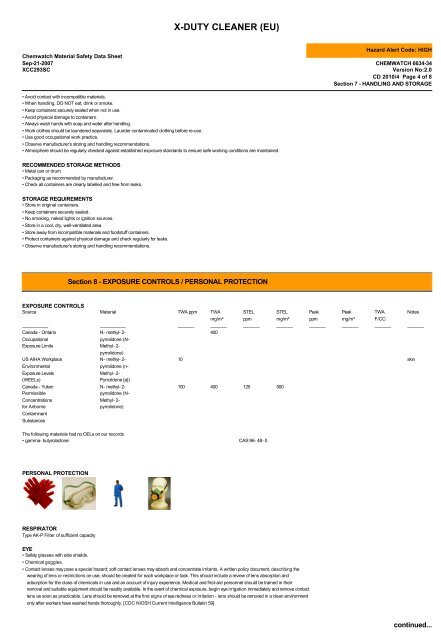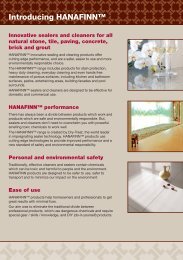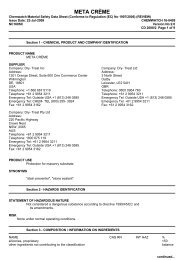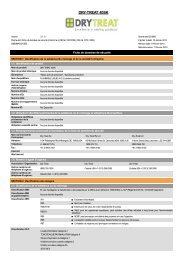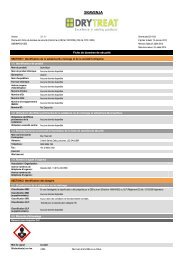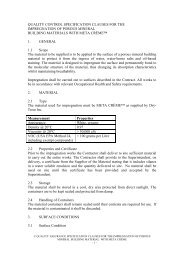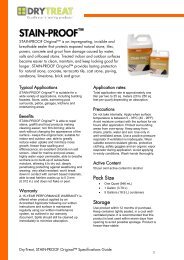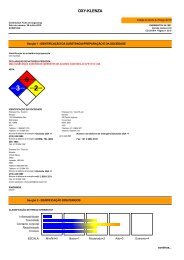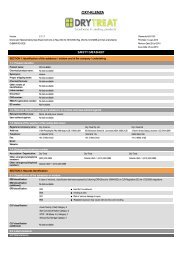Chemwatch MSDS Print - Dry Treat
Chemwatch MSDS Print - Dry Treat
Chemwatch MSDS Print - Dry Treat
Create successful ePaper yourself
Turn your PDF publications into a flip-book with our unique Google optimized e-Paper software.
X-DUTY CLEANER (EU)<br />
Hazard Alert Code: HIGH<br />
<strong>Chemwatch</strong> Material Safety Data Sheet<br />
Sep-21-2007 CHEMWATCH 6634-34<br />
XCC293SC Version No:2.0<br />
CD 2010/4 Page 4 of 8<br />
Section 7 - HANDLING AND STORAGE<br />
• Avoid contact with incompatible materials.<br />
• When handling, DO NOT eat, drink or smoke.<br />
• Keep containers securely sealed when not in use.<br />
• Avoid physical damage to containers.<br />
• Always wash hands with soap and water after handling.<br />
• Work clothes should be laundered separately. Launder contaminated clothing before re-use.<br />
• Use good occupational work practice.<br />
• Observe manufacturer's storing and handling recommendations.<br />
• Atmosphere should be regularly checked against established exposure standards to ensure safe working conditions are maintained.<br />
RECOMMENDED STORAGE METHODS<br />
• Metal can or drum<br />
• Packaging as recommended by manufacturer.<br />
• Check all containers are clearly labelled and free from leaks.<br />
STORAGE REQUIREMENTS<br />
• Store in original containers.<br />
• Keep containers securely sealed.<br />
• No smoking, naked lights or ignition sources.<br />
• Store in a cool, dry, well-ventilated area.<br />
• Store away from incompatible materials and foodstuff containers.<br />
• Protect containers against physical damage and check regularly for leaks.<br />
• Observe manufacturer's storing and handling recommendations.<br />
Section 8 - EXPOSURE CONTROLS / PERSONAL PROTECTION<br />
EXPOSURE CONTROLS<br />
Source Material TWA ppm TWA STEL STEL Peak Peak TWA Notes<br />
mg/m³ ppm mg/m³ ppm mg/m³ F/CC<br />
___________ ___________ _______ _______ _______ _______ _______ _______ _______ _______<br />
Canada - Ontario N- methyl- 2- 400<br />
Occupational pyrrolidone (N-<br />
Exposure Limits Methyl- 2-<br />
pyrrolidone)<br />
US AIHA Workplace N- methyl- 2- 10 skin<br />
Environmental pyrrolidone (n-<br />
Exposure Levels Methyl- 2-<br />
(WEELs) Pyrrolidone [a])<br />
Canada - Yukon N- methyl- 2- 100 400 125 500<br />
Permissible pyrrolidone (N-<br />
Concentrations Methyl- 2for<br />
Airborne pyrrolidone)<br />
Contaminant<br />
Substances<br />
The following materials had no OELs on our records<br />
• gamma- butyrolactone: CAS:96- 48- 0<br />
PERSONAL PROTECTION<br />
RESPIRATOR<br />
Type AK-P Filter of sufficient capacity<br />
EYE<br />
• Safety glasses with side shields.<br />
• Chemical goggles.<br />
• Contact lenses may pose a special hazard; soft contact lenses may absorb and concentrate irritants. A written policy document, describing the<br />
wearing of lens or restrictions on use, should be created for each workplace or task. This should include a review of lens absorption and<br />
adsorption for the class of chemicals in use and an account of injury experience. Medical and first-aid personnel should be trained in their<br />
removal and suitable equipment should be readily available. In the event of chemical exposure, begin eye irrigation immediately and remove contact<br />
lens as soon as practicable. Lens should be removed at the first signs of eye redness or irritation - lens should be removed in a clean environment<br />
only after workers have washed hands thoroughly. [CDC NIOSH Current Intelligence Bulletin 59].<br />
continued...


